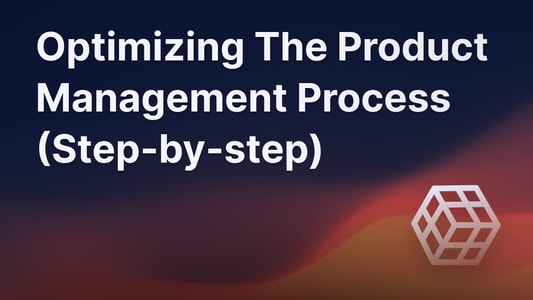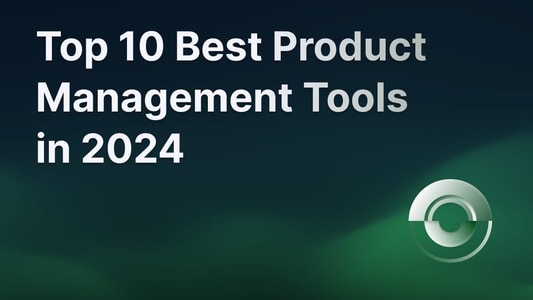Blog Customer FeedbackHow to announce product updates & new features successfully (with examples & templates)
How to announce product updates & new features successfully (with examples & templates)
Announcing product updates is essential to increase new feature adoption. This guide will show you how to create effective product announcements that keep your users informed and engaged. This is your last stop for everything you need to know about product updates.

Looking to increase new feature adoption and customer loyalty with effective product updates? You're in the right place.
In this guide, we'll go over everything from identifying the right audience to crafting the perfect release notes.
Get ready to learn how to make your product updates hit the mark every single time!
What are product updates?
Product updates are changes or improvements made to your product, including new features, bug fixes, performance enhancements, or user interface redesigns.
The goal of product updates is to improve the user experience, add value, and ensure the product remains competitive and relevant.
When to announce product updates?
Deciding the right time to announce product updates depends on the nature and significance of the update itself. It's important to consider what the update is about:
- New features
- New product
- Bug fixes
- Feature updates
- Product redesign
For example, new features and a redesign impact the user experience in a big way, so you should let your users know about them.
But for smaller updates, such as bug fixes or slight improvements, a big announcement is not necessary. Frequent small updates can quickly overwhelm users and get annoying.
👍 A simple rule of thumb is to consider the update's impact on your user's interaction with the product. If it changes how the app or a particular feature functions in a noticeable way, it's worth announcing.
Why do product updates matter?
Product updates show your users that you're listening and committed to improving their experience. When you ship a feature that your customers have been asking for, they feel heard.
This can boost user loyalty & engagement. People are more likely to interact with a product they feel a part of and see is improving.
Moreover, by constantly announcing these updates and educating users on new features, you're helping them get the most out of your product and enhance their overall experience.
Announcing updates can also attract new users. When people see your product is always improving, they're more interested in trying it out for themselves. It can also bring back churned customers who see that the new updates have fixed their old problems.
All in all, a well-crafted release note can impact both current, past, and future customers.
But to actually achieve this, it's crucial to nail the announcement itself.
The 3-step formula for crafting effective product updates
In short, to write an effective product update, there are three key questions you should ask yourself:
- Who’s your target audience?
- What are your goals with the announcement?
- Which channels should you use?
Let’s go over them 👇
1. Defining the target audience
Your target audience is never "everyone". You should focus first on:
- Users who requested the new feature or change - they're your early advocates.
- Active users affected by updates - they need to understand how it impacts their experience.
Segment your users to tailor your messaging effectively.
Many modern changelog tools like Featurebase allow you to sync your customer data to easily send customized updates to different user segments.
For example:
- For those who requested a feature: "You asked, we listened! Check out our latest update."
- For paid users that can use the feature: "Heads up! Here’s what’s new and how you can use it."
- For free users that would have to upgrade: "Check out this new cool feature we released on the pro plan! Upgrade to also benefit from it."
This tailored approach ensures each user group receives messages that resonate with their specific needs and interests.
2. Setting goals for the announcement
Define what success looks like for your announcement. The goals could include:
- Increasing new feature adoption
- Ensuring users are prepared for significant changes
- Encouraging upgrades by highlighting new premium features
- Attracting new customers with your latest features
Understanding your objectives simplifies planning and ensures you focus on the most impactful activities.
Whether it's driving feature adoption with in-app tours or preparing users for upcoming changes, align your strategies with your goals.
3. Choosing the right channels
There are many different communication channels available for sharing product updates.
When making the choice, you should once again consider your target audience and the type of announcement.
For smaller improvements that might not interest everyone, email and in-app notifications could be enough.
However, for launching a new feature with the potential to attract new customers, social media and blogs could be the move.
In all cases, you will benefit from keeping a public changelog page with all of your updates available for everyone to read.
Let's take a look at how it works and other popular channels for product updates.
Where to announce product updates?
1. Public changelog page
A public changelog page is a transparent way to list all your updates, big and small. It's like a detailed diary of your product's evolution, beneficial for users who like to stay informed about every change.
Most changelog tools send out automated email notifications to users to keep them updated. More advanced ones also allow sending different updates for different user segments.
Changelogs are especially useful for SaaS companies, where ongoing improvements and fixes are expected thanks to the subscription model.
Having a public changelog builds trust by showing commitment to improvement and transparency.

2. In-app announcement
Announcing updates directly within your product is highly effective for reaching your active users.
It ensures that the message is seen by customers who are already engaged with your product. Plus, they no longer have to leave your app to read the updates. It's best used for introducing new features or significant changes that affect the user experience.
In-product announcements can include pop-up notifications, banners, or a dedicated "What's New" button.
(They're usually connected to your changelog tool if you have one, so you don't have to make separate updates.)

3. Emails
Email newsletters are ideal for delivering detailed information about updates, including benefits, how-to guides, and answers to potential questions.
They work well for engaging users who may not log into your product regularly but are interested in staying updated. It's also an excellent opportunity to re-engage inactive users by highlighting updates that might interest them.
Most changelog tools will make your life easier and automatically send out notification emails after you post an update.

4. Blog posts
Blog posts enable in-depth discussion about your updates. They allow you to explain the rationale behind changes, the development process, and the impact on users.
Blog posts are most suitable for major updates that require thorough explanation or have a significant story behind them. They can also be used to showcase the team's effort, enhancing user connection to your product.
Here's an example blog post from Linear on how they built Project Updates →
5. Social media
Social media platforms offer a broad reach and the ability to engage with your audience in a more informal and interactive manner.
Announcements on social media can generate excitement and encourage shares, extending your message's reach. This channel is best for highlighting the most appealing aspects of your update, teasing upcoming changes, or sharing success stories related to your updates.
It's particularly effective for reaching potential new users and keeping your community engaged.
Here's a thread of our monthly product updates on X →
What to include in product announcements
When you're putting together a product announcement, you want to ensure it grabs attention and delivers the message clearly. Including the right elements can make all the difference. Here's what you should consider adding:
1. Bullet Points
Use bullet points to break down the key features or updates. This makes the information easy to scan and understand.
Highlight the essentials by picking the most significant changes or new features and list them out. This helps readers quickly grasp the main updates of your announcement.
2. Visuals
Adding images or graphics to your announcement can drastically enhance its attractiveness and engage your audience. Visuals are a powerful tool to "show" rather than "tell" what's new.
If you've updated the design or added a new feature, showing it through a visual can deliver your message more effectively than words alone.
3. Videos
Videos offer a dynamic way to communicate your message and can create a stronger connection with your audience. They're especially useful for demonstrating how new features work or showing off product improvements in a way that text and images alone cannot.
A well-produced video can capture attention and deliver a comprehensive understanding of your updates in a format that's easy to consume and share.
Ahrefs is a prime example of this with their Rapid-Fire Product Updates.
4. Links
Finally, include links to more detailed information, be it a detailed blog post, product documentation, or a FAQ page.
Links can guide users to where they can try new features, sign up for a trial, or directly purchase, making it easy for them to take the next step.
Good to know: Featurebase allows you to link updates to existing feature requests on your feedback board. This way users can see the full request and its comments with a click of a button.
Top product update announcement examples
Understanding the theory behind effective product updates and announcements is one thing, but seeing them in action is another.
Let’s take a look at how different companies utilize these tips to keep their users engaged and informed.
Many of our customers use Featurebase’s changelog tool. They find it simple to use and easy to engage users.
Here's how Reword ships their release notes. Their updates feature a relevant image while being short and simple to read.
The changelog page features a collaborative comment section and reaction where users can engage with them and leave additional feedback.

Something that many of our customers especially love is being able to bring the updates into their own products using beautiful widgets.
"We want to increase new-feature adoption in our SaaS, so we moved to Featurebase. We love the way we are now able to share updates from our product." - Olly, Co-Founder of Senja.io
Here's an example of how Senja brings product updates into their app to boost engagement:

The in-app popup is connected to the changelog page (seen in the previous example). So, writing an update there will automatically queue one in your app - no extra work needed.
Moving forward, we love Daybridge's changelogs for their user-friendliness. You can understand the key updates already from the illustration. They're also easy to read, thanks to the emojis and headings.

If you like the layout of the full changelog page but want to have the updates inside your app, consider a changelog widget. It can be easily connected to a button and will display a notification badge when you post a new update.

Conclusion
All in all, there's no better way to keep all your users involved, engaged, and updated than through intuitive product announcements.
Managing and sharing these updates doesn't have to be a headache. Tools like Featurebase make writing release notes a child's play and help engage your users with automated emails and in-app popups.
Start publishing product updates with Featurebase for free →
The simple feedback tool with feature voting for your customer feedback. Built-in the 🇪🇺.
© 2024 Featurebase. All rights reserved.


